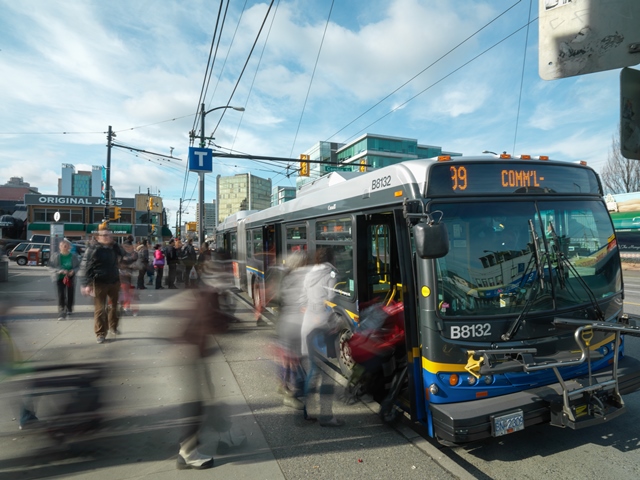The 2013 Bus Service Performance Review is live!
The 2013 Bus Service Performance Review is live!

Okay transit enthusiasts, it is that time of the year where TransLink’s Service Planning department takes stock of how the bus system performed the year before and summarizes it in a Bus System Performance Review. Woohooo! Right?
Here are the quick highlights:
- Customers boarded TransLink buses 228 million times in 2013, up eight million or 3% since 2010.
- More customers are riding the 215 bus routes across the region and productivity in boardings per service hour has increased by 6%.
- Bus productivity remained steady in 2013, despite a slight decline in overall ridership compared to 2012. This is in part a result of service optimization, which shifts service to better match demand and optimizes bus schedules.
- South of Fraser saw the largest increase in service – with an 11% over the last three years, partly due to new services like the King George B-Line and 555 over the Port Mann Bridge, introduced to meet growth in that region.
- South of Fraser experienced the highest growth in annual passenger boardings of 4.3 million between 2010 and 2013.
- Since 2010, Bus ridership grew by 10% or more in Ladner/South Delta/Tsawwassen, Maple Ridge/Pitt Meadows and Richmond.
This review helps identify trends and opportunities for improvement by looking at the performance of the whole bus system, in smaller regional areas, and for each route. Ultimately, this information informs TransLink’s service optimization program, which helps to provide more service to more people across the region with the resources available .
Curious how TransLink manages the transportation network? Check out the Transit Network Primer.
Here is our post on the 2012 Bus Service Performance Review.
Author: Angela Salehi






I appreciate Translink network – though I experienced 3 many late or missing busses today (Tuesday July 15). It took me over one hour extra to complete my trip.
I went to take the 11:52am C30 (in Coquitlam to Coquitlam Town Centre) on Westwood / Glen. The bus never came – either that or it departed early. I had to wait for the 12:19pm one
Then in downtown Vancouver, I wanted to take route 3 from Main / Georgia. I checked the times on translink. Bus due at 1:35pm, didn’t arrive. Waited for next one, didn’t come either. I boarded the one after 2pm – unfortunately by which time, my 3-zone ticket time from Coquitlam had just expired. So I had to get a new ticket.
I hope that Translink can look into this.
fyi… you can check if a bus has recently left or on it’s way on Translink’s site…
http://nb.translink.ca/Map/Route/c30
http://nb.translink.ca/Map/Route/3
I’m downright shocked that the 99 wasn’t first in all categories! The 16 is apparently first in average capacity utilisation and the 49 in peak load factor. That doesn’t seem right, pretty sure the 99 is more packed than the 49.
Hi Joe – good question! Peak load factor refers to the ratio of total passengers on a bus, both seated and standing, versus the total capacity of that bus. We operate both articulated and standard buses on the 49 and just articulated buses on the 99. Both the 49 and 99 are very busy bus routes and when buses are full, it shows a high peak load factor, but this doesn’t account for the different sized buses. Hope this helps. For more details on the terminology used in the Bus Service Performance Review, please refer to Appendix A.
@Joe
And if you read the Average Capacity Utilization definition it talks about how it favours longer routes.
If you think about the differences between the 16 and 99 it makes sense that the 16 ranks higher. For example, the 16 is able to re-use capacity as it is essentially two route: Arbutus to Downtown and Renfrew to Downtown. I don’t think it would affect many riders if the route was split in two (i.e. there aren’t a lot of riders going from Renfrew to Arbutus via downtown) thus during its one trip it gets to count passengers from “two route” in its utilization.
The same can’t be said about the 99. Cutting it in half would certainly affect the majority of the riders. In other words, there isn’t a distinct location where all the passengers turnover like there is for the 16 downtown.
With this in mind I would expect a similar high rank in utilization with routes like the 7 and 22.
I hate bc transit
You must be glad that they haven’t been running the transit system in the Greater Vancouver Area for a long time then.